If you’re looking to improve your grip and wrist strength, then dumbbell forearm exercises are an excellent way to do that.
They’re easy to use and versatile enough to target a variety of muscles in your forearm at home or at the gym.
The forearms play a pivotal role in everyday tasks like lifting, carrying, and gripping, making their strength and conditioning vital for overall performance.
In this blog post, we will delve into the following:
- Forearm Muscles
- Best Dumbbell Forearm Exercise
- Forearm Training Program

- Forearm Muscles
- Flexor Muscles
- Extensor Muscles
- Pronator and Supinator Muscles
- Brachioradialis
- Importance of Stronger Forearm
- 1. Enhanced Performance
- 2. Injury Prevention
- 3. Improve Functional Abilities
- 4. Grip Strength
- 5. Improved Aesthetics
- Dumbbell Forearm Exercises That You Can Do At Home or At Gym
- 1. Seated Dumbbell Wrist Curls
- 2. Dumbbell Reverse Wrist Curl
- 3. Seated Neutral Dumbbell Wrist Curl
- 5. Seated Finger Curl
- 6. Dumbbell Wrist Twist
- 7. Dumbbell Reverse Curl
- 8. Behind-The-Back Dumbbell Finger Curls
- 9. Dumbbell Farmer’s Walk
- 10. Hammer Curl
- 11. Zottman Curl
- 12. Dumbbell Reverse Grip Concentration Curl
- Sets, Reps and Frequency for forearm Workout
- 1. Sets For Forearm
- 2. Repetitions (Reps) For Forearm
- 3. Frequency Of Forearm Workout
- Dumbbell Only Forearm Workout Samples plan
- 1. Beginner Forearm Workout Plan
- 2. Intermediate Forearm Workout Plan
- 3. Advanced Forearm Workout Plan
- Benefits Of Doing Forearm Exercises With Dumbbells
- 1. Convenience and Versatility
- 2. Balance and Symmetry
- 3. They Allow Variable Loading
- 3. Increased Range of Motion
- Conclusion
- References:
Forearm Muscles
The forearm is a complex area of the upper limb that contains numerous muscles responsible for various movements and functions.
To effectively target the forearm muscles with dumbbell exercises, it is essential to understand them.
Let’s delve into the key muscles of the forearm:
Flexor Muscles
- Flexor Digitorum Profundus: This muscle runs along the forearm and is responsible for flexing the fingers.
- Flexor Digitorum Superficialis: Positioned above the flexor digitorum profundus, this muscle flexes the fingers as well.
- Flexor Carpi Radialis: Located on the inner side of the forearm, this muscle flexes and abducts the wrist.
- Palmaris Longus: this muscle aids in wrist flexion and tenses the palmar aponeurosis.
Extensor Muscles
- Extensor Digitorum: Positioned on the back of the forearm, this muscle extends the fingers.
- Extensor Carpi Ulnaris: Located on the outer side of the forearm, this muscle extends and adducts the wrist.
- Extensor Carpi Radialis Longus and Brevis: These muscles extend and abduct the wrist.
Pronator and Supinator Muscles
- Pronator Teres: Positioned on the inner side of the forearm, this muscle pronates the forearm (rotates it to face downward).
- Pronator Quadratus: Located near the wrist, this muscle assists in pronation.
- Supinator: Situated on the outer side of the forearm, this muscle supinates the forearm (rotates it to face upward).
Brachioradialis
This muscle runs along the outer side of the forearm and aids in flexion and rotation of the forearm.
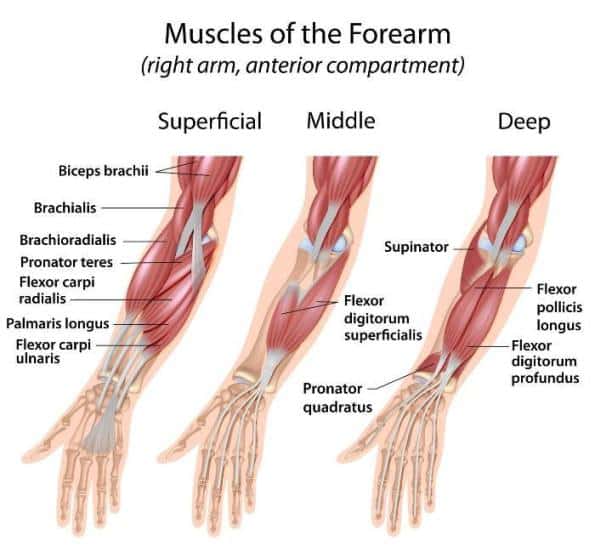
Importance of Stronger Forearm
Having stronger forearms is important for several reasons:
1. Enhanced Performance
Strong forearms contribute to improved performance in various activities and sports that involve gripping, lifting, and manipulating objects.
Forearm strength helps in tasks such as weightlifting, rock climbing, golf swings, racket sports, and many others.
A study published in the journal Science found a significant correlation between stronger forearms and performance in exercises such as deadlifts and bench presses.
2. Injury Prevention
Strong forearms provide stability and support to the wrist and elbow joints, which reduces the risk of strain and stress-related injuries.
A study has also shown that stronger forearms can prevent common injuries like tennis elbow (lateral epicondylitis) and other overuse injuries.
3. Improve Functional Abilities
Your strong forearms improve your ability to handle everyday activities with ease and efficiency.
It is essential to have strong arms for daily functional tasks, including carrying groceries, opening jars, gripping tools, and performing manual labor.
4. Grip Strength
Grip Strength is directly related to forearm strength. A strong grasp is essential for numerous sports, work-related tasks, and activities that require a firm hold.
Developing a stronger grip can lead to improvements in other strength exercises like deadlifts, pull-ups, and rows. It can also enhance performance in exercises that require holding or manipulating weights.
5. Improved Aesthetics
Having well-developed forearms contributes to a balanced and aesthetic physique. The forearm muscles can be strengthened and toned to make the arms look bigger and more defined.
Dumbbell Forearm Exercises That You Can Do At Home or At Gym
It’s important to choose exercises that work multiple forearm muscles at the same time to improve forearm training and grip strength.
This approach ensures efficiency, as we aim to avoid spending excessive time exclusively on forearm training.
By focusing on exercises that work the majority of the small muscles in the forearm, we can get the most out of the workout.
1. Seated Dumbbell Wrist Curls
Seated dumbbell wrist curls are isolation exercises that primarily target the muscles responsible for wrist flexion, specifically the wrist flexor group.
It is a simple but effective exercise that helps to strengthen the muscles in the forearms and wrists.
The exercise is typically performed using a barbell or a pair of dumbbells and it can be done seated or standing.
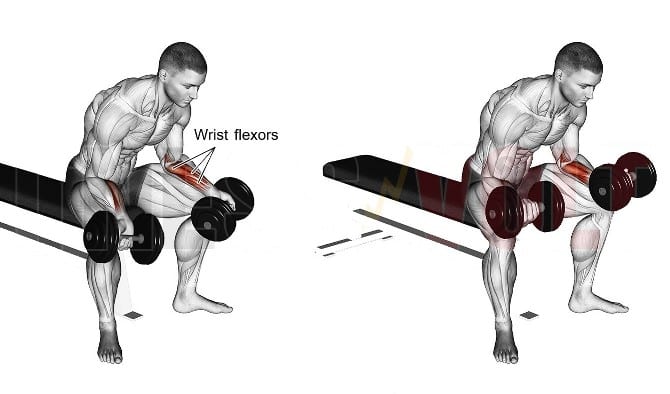
How To Do Palms-Up Wrist Curl
- Sit on a flat bench with your legs bent and your feet flat on the floor.
- Place your forearms on your thighs, with your wrists hanging off the edge.
- Hold a barbell or a pair of dumbbells with your palms facing up.
- Slowly bend your wrists to lower the weight towards your fingers, keeping your upper arms stationary.
- Hold for a moment at the bottom of the movement, then slowly extend your wrists to raise the weight back to the starting position.
- Repeat for the desired number of reps and sets.
2. Dumbbell Reverse Wrist Curl
Reverse wrist curls are similar to regular wrist curls, but with a reversed hand position. It primarily targets the extensor muscles (back of the forearm).
Strong extensor muscles contribute to better grip stability and control. This can be beneficial in activities that require a firm grip, such as weightlifting, racket sports, and manual labor.
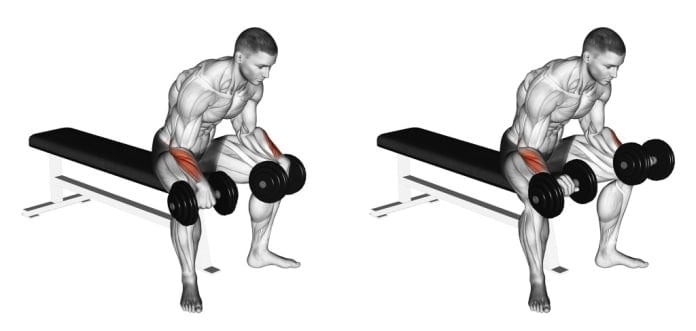
How To Do Palms-Down Wrist Curl
- Sit on a flat bench with your legs bent and your feet flat on the floor.
- Place your forearms on your thighs, with your wrists hanging off the edge.
- Hold a barbell or a pair of dumbbells with your palms facing down.
- Slowly bend your wrists to raise the weight towards your forearms, keeping your upper arms stationary.
- Hold for a moment at the top of the movement, then slowly extend your wrists to lower the weight back to the starting position.
- Repeat for the desired number of reps and sets.
3. Seated Neutral Dumbbell Wrist Curl
The seated neutral dumbbell wrist curl specifically targets the flexor muscles of the forearms. Using a dumbbell with a neutral grip (palms facing each other) to perform wrist curls while seated.
This workout enhances hand-grip endurance, which is especially beneficial for activities that demand steady hand-grip power over time, like climbing rocks or playing tennis.
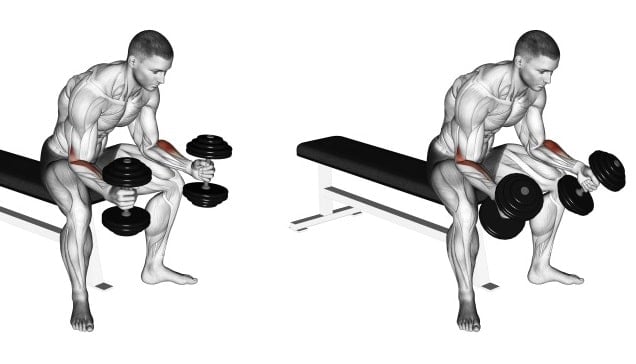
How To Do Neutral Dumbbell Wrist Curl
- Sit on a bench or chair with your feet planted on the ground and your back straight.
- Hold a dumbbell in each hand with a neutral grip (palms facing each other).
- Rest your forearms on your thighs, allowing your wrists to hang off the edge.
- Slowly curl your wrists upward by flexing the forearms while keeping your forearms stationary.
- Hold the peak contraction for a moment and then lower the dumbbells back down to the starting position in a controlled manner.
- Repeat for the desired number of repetitions.
5. Seated Finger Curl
The seated finger curl is another great exercise for your dumbbell forearm workout. It is a forearm exercise that specifically targets the muscles responsible for finger flexion.
Dumbbell finger roll is particularly effective for strengthening the fingers and grip strength.
A solid grip and strong fingers are beneficial for activities that require grasping, holding, or manipulating objects, such as weightlifting, rock climbing, and everyday tasks.
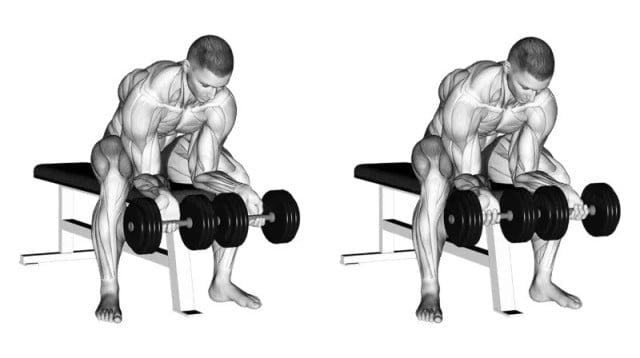
How To Do Dumbbell Finger Rolls
- Sit on a bench or chair with your back straight and feet flat on the floor.
- Hold a dumbbell in each hand, palms facing up.
- Start with the dumbbells hanging at arm’s length in front of your thighs.
- Lower the dumbbells as far as possible by extending your fingers, allowing them to roll down your hands.
- Catch the dumbbells with the final joint in your fingers.
- Curl the dumbbells up as high as possible by closing your hands, flexing your fingers, and squeezing the dumbbells.
- Exhale as you curl the dumbbells up and hold the contraction at the top for a moment.
- Slowly lower the dumbbells back to the starting position, extending your fingers and allowing the dumbbells to roll down your hands.
- Repeat for the desired number of repetitions.
6. Dumbbell Wrist Twist
The dumbbell wrist twist, also known as pronation and supination, is an exercise that focuses on strengthening the muscles responsible for rotating the forearm, specifically the pronators and supinators forearm muscles.
It involves holding a dumbbell and rotating the wrist to perform pronation (inward rotation) and supination (outward rotation) movements.
This exercise mimics the rotational movements required in many daily activities and sports, such as turning a doorknob, swinging a golf club, or throwing a ball.
How To Do Dumbbell Wrist Twist
- Stand or sit with proper posture and hold a dumbbell with an underhand grip (palms facing up) in one hand.
- Rest your forearm on a bench or thigh, keeping your wrist just beyond the edge and allowing it to move freely.
- Start with the dumbbell hanging down, parallel to the floor, and your palm facing inward (pronation).
- Slowly rotate your wrist outward, moving the dumbbell upward until your palm is facing upward (supination).
- Pause briefly at the top of the movement, then rotate your wrist back inward to return to the starting position.
- Repeat for the desired number of repetitions, and then switch to the other hand.
7. Dumbbell Reverse Curl
The Dumbbell Reverse curl is a variation of the standard bicep curl, where the barbell is gripped palms up. It targets your brachioradialis, brachialis and many other muscles in your forearms.
The motion is the same, but the change in grip allows for specific arm muscles to be targeted.

How To Do Dumbbell Reverse Curl
- Stand straight, keeping your feet shoulder-width apart.
- Grab a dumbbell in each hand using an overhand grip, and arms should be fully extended.
- Keeping your upper arms stationary and your back straight, curl the weights up towards your shoulders, exhale as you do so. Use only your forearms for this movement.
- Continue curling the dumbbells until they are at shoulder level and your biceps are fully contracted.
- Return to the starting position in a smooth arc, inhale as you do so.
Tips
- Rotate the forearms slowly, excessive-velocity may cause issues within the elbows or wrists.
- Using a slow eccentric of the exercise can help to improve tension and mind-muscle connection.
- Be aware of proper weight and body mechanics at all times during this exercise.
8. Behind-The-Back Dumbbell Finger Curls
Behind-the-back dumbbell finger curls are a variation of finger curls that primarily focus on strengthening the muscles of the fingers and forearms.
Behind your back curl, increases the range of motion and puts more emphasis on finger flexion.

How To Do It
- Stand with your feet shoulder-width apart and hold a dumbbell in each hand.
- Rotate your arms externally, bringing the dumbbells behind your back, with your palms facing backward.
- Let your arms naturally hang down with the dumbbells behind your hips.
- Keeping your arms still, curl your fingers and squeeze, flexing your fingers as much as you can.
- Hold the contracted position for a moment, then slowly release and extend your fingers to return to the starting position.
- Repeat for the desired number of repetitions.
9. Dumbbell Farmer’s Walk
The Farmer’s walk is a functional exercise that can be used to build overall grip and forearm strength. The exercise involves holding a pair of heavy dumbbells at your sides and walking with them for a set distance or time.
It is relatively simple to perform, but can be quite challenging as the weight used for this exercise is usually quite heavy.
This exercise can be quite challenging, it is recommended to start with a moderate weight, and increase it gradually as you build up your strength.

How To Do
- Start by selecting a pair of heavy dumbbells, which are challenging but still manageable to hold.
- Stand with your feet hip-width apart and your knees slightly bent.
- Take a dumbbell in each hand and let them hang at your sides.
- Keep your back straight and your core engaged throughout the exercise.
- Begin walking forward, keeping a steady pace and maintaining good form.
- Walk for the desired distance or time, then release the weight and rest for a moment before repeating.
10. Hammer Curl
The Hammer Curl is a classic weightlifting exercise that targets the biceps and brachialis.
When it comes to building muscular hypertrophy and strength, the hammer curl exercise is one of the most popular brachialis exercises among bodybuilders and regular weightlifters.

How To Do
- Stand with your feet shoulder-width apart and a slight bend in your knees.
- Hold a pair of dumbbells in your hands with your palms facing towards your body.
- Keeping your elbows close to your body, slowly curl the dumbbell up to your shoulders.
- At the top of the lift, pause for a second and squeeze your brachialis, then lower the weights under control.
Tips
- Raise and lower the dumbbell slowly. Keep in control by using your own strength, not using momentum or gravity.
- Neither lean back as you lift the weight nor lean forward as you lower it.
11. Zottman Curl
The dumbbell zottman curl is one of the best variations of the standard bicep curl. The Zottman curl utilizes different hand positioning at different portions of the lift.
The first portion, the regular curl, focuses on forearm and bicep strength.
You can perform Zottman curls with both arms at the same time, or alternate the arm you lift with.

How To Do
- Hold a pair of dumbbells to your sides.
- Keep your palms facing up as you curl the weights up to your shoulders.
- Pause at the top of the movement.
- Slowly rotate your grip, so your palms are facing downwards.
- Lower the dumbbells slowly back to the starting position using an overhand grip.
- When the dumbbells are close to your thighs, again turn your hands while returning to the starting position.
Tips
- Perform this exercise in a slow, controlled manner for best results.
- Don’t go heavy. Choose a lighter weight and focus on perfecting your form.
12. Dumbbell Reverse Grip Concentration Curl
The Reverse grip dumbbell concentration curl is a great basic move to do. When done correctly, it can effectively target your arms, forearms, and upper body.
The dumbbell reverse-grip concentration curl is an isolation exercise that targets the biceps brachii and brachialis muscles.

How To Do
- Sit on a bench with your legs apart, grab a dumbbell in one hand (say left hand).
- With your left arm almost fully extended, rest your elbow against the inside of your left thigh.
- Pronate your wrist so that your palm faces backward.
- Exhale as you curl the dumbbell up towards your shoulder.
- Hold and squeeze your biceps for a count of two.
- Inhale as you slowly lower the dumbbell to the starting position.
- Repeat with your right arm.
Tips
- Don’t lockout at the bottom of the exercise.
- Keep your back straight and your upper arm still.
Sets, Reps and Frequency for forearm Workout
Forearm exercises should be performed at a frequency that is appropriate for each individuals’ fitness level, goals, and recovery ability.
Nevertheless, there are some general guidelines to help you get started.
1. Sets For Forearm
- Beginners: Start with 2-3 sets per exercise.
- Intermediate: Aim for 3-4 sets per exercise.
- Advanced: Perform 4-5 sets per exercise.
2. Repetitions (Reps) For Forearm
- Strength and Power: Focus on lower reps (around 6-8) with heavier weights to challenge the muscles and promote strength gains.
- Hypertrophy (Muscle Growth): Aim for moderate reps (around 8-12) with weights that fatigue the muscles within the desired rep range.
- Endurance: Perform higher reps (around 12-15 or more) with lighter weights to build muscular endurance.
3. Frequency Of Forearm Workout
- Beginners: Start with 1-2 forearm workouts per week, allowing ample recovery time between sessions.
- Intermediate: Aim for 2-3 forearm workouts per week, with at least two days of rest in between.
- Advanced: Perform 3-4 forearm workouts per week, incorporating variety in exercises and intensity levels.
Dumbbell Only Forearm Workout Samples plan
1. Beginner Forearm Workout Plan
| Exercise | Reps | Sets |
|---|---|---|
| Dumbbell Wrist Curls | 10-12 | 3 |
| Reverse Dumbbell Wrist Curls | 10-12 | 3 |
| Farmer’s Walk (with Dumbbells) | 30 seconds | 3 |
2. Intermediate Forearm Workout Plan
| Exercise | Reps | Sets |
|---|---|---|
| Dumbbell Wrist Curls | 8-10 | 4 |
| Reverse Dumbbell Wrist Curls | 8-10 | 4 |
| Behind-the-Back Wrist Curls | 10-12 | 3 |
3. Advanced Forearm Workout Plan
| Exercise | Reps | Sets |
|---|---|---|
| Dumbbell Wrist Curls | 6-8 | 5 |
| Reverse Dumbbell Wrist Curls | 6-8 | 5 |
| Behind-the-Back Wrist Curls | 8-10 | 4 |
| Dumbbell Wrist Twist | 10-12 | 3 |
Benefits Of Doing Forearm Exercises With Dumbbells
There are several benefits to training the forearms with dumbbells.
1. Convenience and Versatility
Dumbbells are easily accessible and can be used in various settings, whether at home, in a gym, or outdoors.
They offer great movement variability, allowing you to perform a wide range of forearm exercises to target different muscle groups and angles.
2. Balance and Symmetry
Forearm exercises with dumbbells provide an opportunity for unilateral training, allowing you to work each forearm independently.
This helps address any muscle imbalances that may exist between your dominant and non-dominant arms, leading to improved overall balance and symmetry in your physique.
3. They Allow Variable Loading
One of the key advantages of using dumbbell for forearm exercises is the ability to have variable loading.
In most gyms, dumbbells are available in a wide range of weights, typically in increments of 2.5 kg and ideally with 1 kg increments from 1-10 kg.
Unlike certain machines or barbells, dumbbells provide the flexibility to increase the load gradually and in smaller increments.
3. Increased Range of Motion
Dumbbells allow for a greater range of motion compared to other forearm training tools.
It allows you to fully engage and target the forearm muscles, leading to improved muscle activation and development.
Conclusion
Dumbbell forearm exercises are an excellent way to improve your grip strength and wrist stability. Dumbbells provide a versatile and effective way to train your forearms, providing movement variability and the ability to perform unilateral exercises.
With just a dumbbell in each hand, you can achieve impressive results. For improved performance, it is important to target the wrist flexor, extensor, pronator, and supinator muscles.
To ensure continued progress, it’s important to continuously challenge yourself. As you get better at the exercises, try increasing the weights, adding new exercises, or changing the intensity or volume of your workouts.
References:
- Mathiowetz, V., et al. (2004). Grip and Pinch Strength: Norms for 6- to 19-Year-Olds. The American Journal of Occupational Therapy, 58(2), 97-104.
- Stasinopoulos, D., & Johnson, M. I. (2007). Cyriax Physiotherapy for Tennis Elbow/lateral Epicondylitis. British Journal of Sports Medicine, 41(11), 639-642.

Manish brings over 10 years of hands-on experience in weight lifting and fat loss to fitness coaching. He specializes in gym-based training and has a lot of knowledge about exercise, lifting technique, biomechanics, and more.
Through “Fit Life Regime,” he generously shares the insights he’s gained over a decade in the field. His goal is to equip others with the knowledge to start their own fitness journey.
